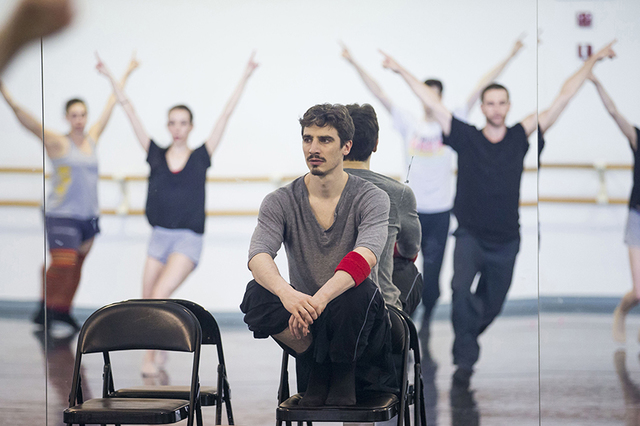Pacific Northwest Ballet director Peter Boal often uses the annual “Director’s Choice” program to introduce local audiences to new works by new choreographers, as he continues to look toward the future of the art form. But this time, with a mix of revivals and restagings, we’re getting a new view of dancemakers we’ve already seen.
As both a ballet master and scheduler for PNB, Paul Gibson doesn’t really have much extra time to make ballets—his trajectory as a choreographer is developing slowly. With Rush, a revision of a work from 2002, he’s continuing very clearly in the neoclassic tradition, working out some of the same technical challenges and spatial puzzles as stylistic forefathers Marius Petipa and George Balanchine while using most of the same tools. Set to Bohuslav Martinu’s Double Concerto for Two String Orchestras, Piano, and Timpani, the ballet responds to the score’s drive and energy to create a formal showcase for company dancers. This style is a fundamental part of PNB’s heritage, and Seth Orza and Noelani Pantastico danced the central couple with great amplitude on Saturday night.
In 2012 Alejandro Cerrudo, resident choreographer for Chicago’s Hubbard Street Dance Company, made Memory Glow for PNB. With this new-to-us production of Little mortal jump from the same year, we get another look at his densely layered and slippery movement style. Jump is charmingly nostalgic, laced with references to silent film and theatrical tricks that work best when they’re unexpected. Cerrudo has assembled a score from several different musicians, from Tom Waits to Philip Glass, and devised a collection of kinetic encounters to match. Leah Merchant has a real affinity for Cerrudo’s style, making long phrases out of seemingly non-sequitur movements and performing them with a kind of movie-star sangfroid. Cerrudo comes from a contemporary-dance background, mixing elements of ballet and modern; his work can challenge the company expressively as well as technically. Much of jump is fairly lighthearted, but the dance shifts into a more somber tone in a duet with Dylan Wald and Elizabeth Murphy, who were able to keep a dramatic thread clear through several changes in speed and dynamics.
Choreographer Justin Peck’s 2014 Debonair, made for PNB, lives up to its title as a sophisticated ballet of manners—his 2012 Year of the Rabbit, which closes this program, is more of an eccentric romp. Peck’s career as a dance maker is on a very fast track. Rabbit was his first work for New York City Ballet, where he was named resident choreographer just two years later in 2014. In the past four years he’s made eight works for NYCB alongside numerous commissions for outside companies; if you learn from experience, he’s had an intense education. During all this time he’s continued to perform with NYCB, often in the corps de ballet, and it’s that point of view that he explores most intriguingly with this work. Peck has created a multitude of intricate maneuvers for the ensemble, sometimes amplifying or commenting on the soloists, but just as often working independently. They resemble a group of kids on a playground, following the rules to an elaborate game, as likely to slide on their butts as to waltz. This sense of freedom extends to the soloists as well, so that we are often challenged to keep track of multiple action onstage. Peck’s ability to connect his classical training to a wider world of movement possibilities is quite extraordinary here—the most impressive thing about these choices is how inevitable he makes them look.
Rabbit is loosely based on the Chinese zodiac, and danced to an orchestration of Sufjan Stevens’ “Enjoy Your Rabbit,” but there are few specifics from Asian astrology. Instead there is a real sense of innovation within a classical matrix, which leaves us wondering what might happen next. McCaw Hall, 321 Mercer St., 441-2424, pnb.org. $30–$187. 7:30 p.m. Thurs., March 24–Sat., March 26; 1 p.m. Sun., March 27.








